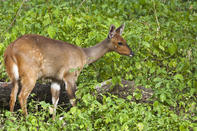
Name
Bushbuck or Imbabala (Tragelaphus sylvaticus)Appearance
The bushbuck is closely related to the nyala and the kudu. Rams are graceful in appearance with a dark greyish-brown fur, white spots on the flanks and white socks. They measure 700mm at the shoulders, and at maximum weigh 54 kg. Ewes are smaller and lighter in colour than the rams, with more distinct stripes and spots.
On the ears, legs, tail, chin and neck, both sexes have geometrically shaped white patches, and a white band at the base of the neck.
The markings on rams become prominent in their displays of arching their backs, slowly circling one another in a tense. high-stepping gait. This is done in order to maintain the strict age-based hierarchy of dominance amongst the rams, showing that fighting would be unnecessary.
Bushbuck Diet
Bushbuck are largely grazers, and selective eaters. They will rarely feed on grass, but are able to adapt their habits for survival.Bushbuck Breeding
Ewes are able to reproduce twice a year with a gestation period of six to seven months. After giving birth, the mother licks her young clean and eats the placenta. In dry regions, birth peaks during the rainy months. No peaks occur in areas of high rainfall.
The mother leaves the calf unaccompanied and well hidden for long times during the day until it is about 4 months old. When she visits to suckle her calf, she eats its dung to eliminate its scent detectable to predators.
Ewes reach sexual maturity at about 2 years of age. Although rams are sexually mature at 11 months, they do not mate until they are socially competent at about 3 years of age.
Bushbuck Behaviour
Bushbucks are most active during the early morning and part of the night. When likely to be disturbed during the day, they can become entirely nocturnal. In the case of being alarmed, they can react by sinking to the ground and lying flat, may leap away or bark hoarsely.
When surprised in the open, they stand dead still or slowly walk to the nearest cover. Most of their day is spent grazing and standing. They are the only non-territorial and solitary African antelope.
Ewes prefer to limit engagement with their young to no more than a few hours a day, and adult rams actively avoid eye contact with one another. Neither rams nor ewes defend their home ranges, often overlapping with the home ranges of other bushbuck.
Bushbuck Habitat
Bushbucks are always found close to permanent water sources, and prefer dense bush at the foot of mountains or along rivers as their habitat.Where they are found
Bushbuck are widely distributed across sub-Saharan Africa, and live in habitats located from sea level to mountaintops, from rainforests to sub-desert terrains.
They are found in a variety of habitats in East Africa, and rarely on open land. The colours and patterns of their coats vary individually and regionally.
Predators
The leopard, lion, hyena and the cheetah are the greatest predatory threat to the bushbuck when on the run. However, the ram will defend himself by dangerously fighting back when cornered.
Despite baboons at times eating the bushbuck’s young, they continue to associate closely with baboons by feeding on the fallen fruits and other foods they dropped when foraging.
 Browsers but take some grass; eat buds, flowers and fruit...
Browsers but take some grass; eat buds, flowers and fruit... Bushbuck are the smallest tragelaphines (spiral-horned antelope) in the Lowveld and in some areas are shy and secretive and in others quite ...
Bushbuck are the smallest tragelaphines (spiral-horned antelope) in the Lowveld and in some areas are shy and secretive and in others quite ...